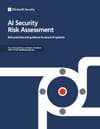⚡ Quick Summary
This whitepaper provides a comprehensive, lifecycle-based risk assessment framework tailored to AI systems. Developed by Microsoft, it adapts familiar cybersecurity standards (ISO 27001, NIST 800-53, etc.) to the unique security challenges posed by ML/AI—such as data poisoning, model inversion, and pipeline compromise. The framework maps risks to controls across data handling, model training, deployment, monitoring, and recovery. Designed to plug into existing enterprise risk programs, it gives security, ML, and compliance teams a shared language and practical playbook to assess and improve AI system resilience.
🧩 What’s Covered
1. Motivation & Scope
- Based on a Microsoft study of 28 organizations; 89% lacked tools to secure ML systems
- Focuses on production-grade AI across the full lifecycle: collection → processing → training → deployment → incident response
2. Risk Prioritization Framework
- Introduces a severity matrix using likelihood, impact, and exploitability
- Defines five severity tiers (critical → informational) based on data sensitivity, system criticality, and downstream harms
- Aligns risk management strategy with defense-in-depth and compensating controls
3. Lifecycle-Driven Risk Categories and Controls
Each stage includes:
- Control objective
- Threat statement
- Recommended mitigations (product/vendor neutral)
DATA STAGE
- Collection: Source trust, consent, metadata tagging
- Storage: Classification, encryption, asset tracking, access control
- Access: RBAC, cryptographic verification, audit logs
- Integrity: Hashing, dataset versioning, unauthorized change detection
PROCESSING & TRAINING STAGE
- Processing Pipelines: Track data through staging environments; separate prod/dev
- Dataset Aperture: Track and govern subsets to reduce leakage or bias
- Model Design: Review code, trace metadata, enforce fine-tuning rules
- Training Practices: Robust against adversarial input, include temporal drift handling
- Model Selection: Avoid overfitting via cross-validation, track metrics
- Versioning: Distinguish prod vs. dev; maintain audit trail
DEPLOYMENT & MONITORING
- Security Testing: Formal acceptance criteria, automated testing
- Compliance Reviews: Network segmentation, regulatory alignment
- Logging: Centralized logs, anomaly detection, review cycles
- Incident Response: Role-based escalation paths, tested playbooks
- Business Continuity: DR plans, impact prioritization, retesting schedules
4. Visuals & Templates
- Severity matrix on page 7 maps attack types (e.g., evasion, inversion, poisoning) against likelihood, impact, and exploitability
- Examples of annotated risk controls on page 9 illustrate structure: objective → threat → control → guidance
💡 Why it matters?
This is the most mature, lifecycle-grounded AI security risk tool released by a major vendor. Unlike abstract threat lists or model-centric taxonomies, it delivers operational value to enterprise teams already working with ISO, NIST, or FedRAMP standards. As regulators begin requiring AI-specific safeguards, this paper provides a ready-to-integrate overlay without reinventing InfoSec governance from scratch.
❓ What’s Missing
- No downloadable checklist or spreadsheet to conduct the assessment
- No quantitative scoring model or prioritization engine
- Focused primarily on Azure-aligned environments, despite being platform-neutral
- Light on social and organizational risks (e.g., insider misuse, human-AI feedback loops)
- Doesn’t address post-deployment agentic systems or autonomous retraining flows
👥 Best For
- AI security leads designing defense-in-depth for deployed ML systems
- CISOs and security architects adapting existing ISO/NIST frameworks for AI
- ML engineers and data scientists looking to build secure-by-design pipelines
- Third-party assessors and auditors needing risk templates for AI tooling
- Regulated firms (finance, health, infrastructure) creating audit-ready security postures
📄 Source Details
- Title: AI Security Risk Assessment: Best Practices and Guidance to Secure AI Systems
- Publisher: Microsoft
- Authors: Will Pearce, Hyrum Anderson, Ram Shankar Siva Kumar, Andrew Paverd, et al.
- Published: 2024
- Length: 20 pages
- License: Open access (living document)
- Contact: atml@microsoft.com
- Reference Frameworks: ISO 27001:2013, NIST 800-53, PCI-DSS, FedRAMP
📝 Thanks to Microsoft’s AI Red Team, Azure Security, and Aether groups for bringing threat modeling and traditional risk language into the AI security playbook—where it’s long been missing.


